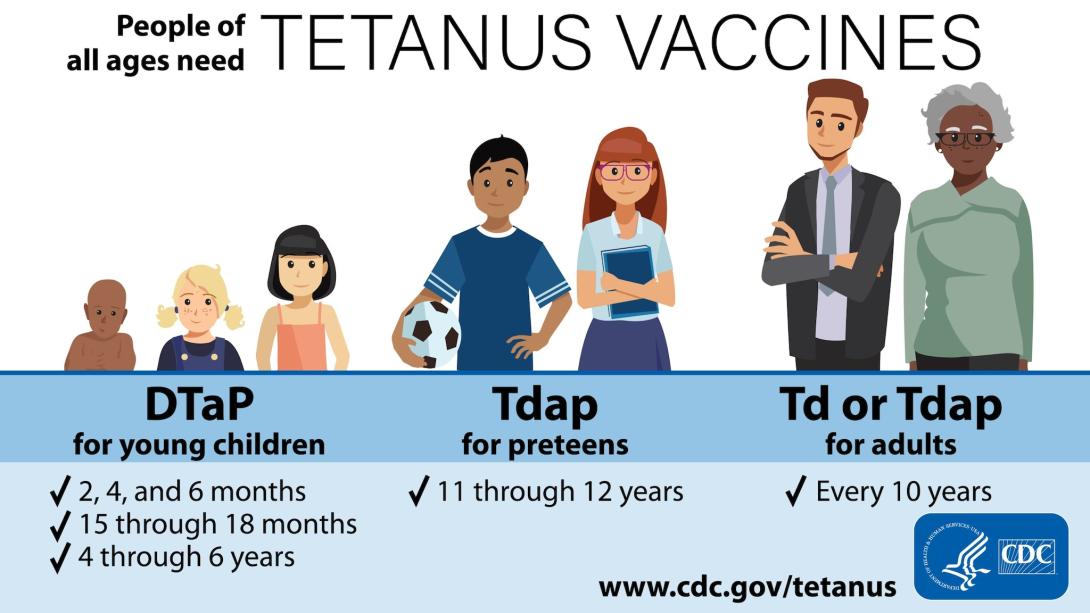About Tetanus
Tetanus is different from other vaccine-preventable diseases because it does not spread from person to person. The bacteria are usually found in soil, dust, and manure and enter the body through breaks in the skin — usually cuts or puncture wounds caused by contaminated objects.
Today, tetanus is uncommon in the United States, with an average of about 30 reported cases each year. Nearly all cases of tetanus are among people who did not get all the recommended tetanus vaccinations. This includes people who have never received a tetanus vaccine and adults who don’t stay up to date on their 10-year booster shots.
Signs and Symptoma
Symptoms typically occur between 3 and 21 days (average 8 days) after someone is exposed to C. tetani.
The first sign is most commonly spasms of the jaw muscles, or "lockjaw."
Other symptoms can include:
- Trouble swallowing
- Sudden, involuntary muscle spams — often in the stomach
- Painful muscle stiffness all over the body
- Seizures (jerking or staring)
- Headache
- Fever and sweating
- Changes in blood pressure and heart rate
Contact your healthcare provider
Tetanus requires immediate treatment. Contact your healthcare provider if you have tetanus symptoms.
Complications
Tetanus can cause serious health problems, including:
- Laryngospasm (uncontrolled tightening of the vocal cords)
- Fracture (broken bone)
- Pulmonary embolism (blockage in lungs caused by a blood clot)
- Aspiration pneumonia (lung infection from inhaling spit or vomit)
- Breathing difficulty
Tetanus can lead to death (1 in 10 cases in the United States are fatal).
Risk factors
Anyone can get tetanus. However, several factors can increase risk for tetanus infection.
Vaccination status
People who have never received a tetanus vaccine are at increased risk. Similarly, people who are not up to date with their 10-year tetanus booster shots are also at increased risk.
Recent wound
People with a recent wound are at increased risk for tetanus. This is especially true if the wound is deep or contaminated with dirt.
Other risk factors
The following risk factors also increase risk of tetanus:
- Being 70 years or older
- Having diabetes
- Having an imunocompromising condition
- Using injection drugs
Causes
Tetanus bacteria can get into someone's body through broken skin, usually through injuries.
> KEEP READING: Tetanus: Causes and How It Spreads
Prevention

Vaccination is the best way to protect against tetanus
CDC recommends tetanus vaccines for everyone. The best way to prevent tetanus is to get vaccinated. CDC recommends tetanus vaccination for everyone.
> KEEP READING: Vaccination
Care for wounds to prevent infection
Immediate and good wound care can also help prevent infection.
- Apply first aid to even minor, non-infected wounds
- Wash hands with soap and water or use an alcohol-based hand rub
- Consult a healthcare provider if you have concerns and need advice
Medicine may be needed in some cases
Medicine called human tetanus immune globulin (TIG) can help prevent tetanus. Healthcare providers can use it when someone isn't up to date with tetanus vaccination and has serious or contaminated wounds.
Testing and diagnosis
Healthcare providers usually decide if someone has tetanus by looking for common signs and symptoms. They may also ask about a recent history of cuts, scrapes, punctures, and trauma.
No lab tests can confirm tetanus.
Treatment and recovery
Tetanus is a medical emergency requiring:
- Evaluation and care in the hospital
- Immediate treatment with TIG
- Aggressive wound care
- Drugs to control muscle spasms
- Antibiotics
- Tetanus vaccination
Depending on how serious the infection is, someone with tetanus may need a machine to help them breathe.

